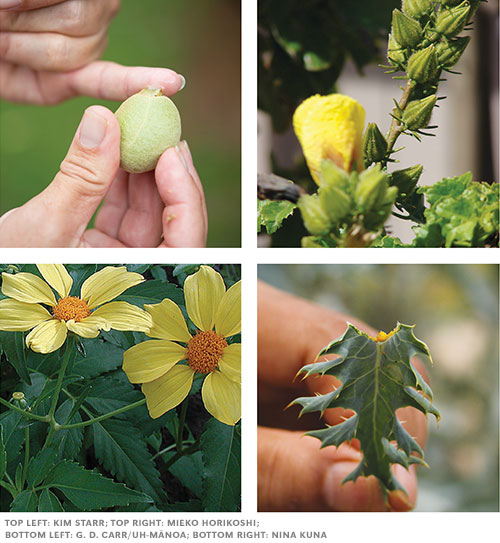
Early Hawaiians led active lives, ate fresh foods, and consulted with kāhuna lapa‘au whenever they suffered from illness or injury. Every Hawaiian family had a healer: a person trained to diagnose, gather and prepare plant medicine, and administer cures. Children who showed aptitude in botany or caregiving began learning alongside their elders.
In addition to herbal medicine, Hawaiian healers incorporated lomilomi to relieve pain, correct malformations, stimulate blood flow, and set bones. They prescribed steam treatments and immersion in fresh or salt water. Many ailments were viewed as having emotional or spiritual causes, so kahuna often guided patients through ho‘oponopono, conflict-resolution techniques to restore balance within an individual and his or her community. Hawaiian healers acted as doctor, pharmacist, and psychologist, treating the whole person rather than isolated symptoms. Prayers and protocols guided each step of the healing process.
For centuries, Hawai‘i’s geographic isolation spared its residents from the epidemics that swept across the continents. But when Western ships arrived in 1778, they brought foreign contagions for which Pacific Islanders had no immunity. Smallpox, tuberculosis, and venereal disease decimated the native population. The intense colonization that followed had a similar effect on Hawaiian cultural practices, including the healing arts.
Dr. Nils Larsen lamented this double tragedy. The Cornell-trained physician served as the chief of medical staff at Queens Hospital in Honolulu from 1924 to 1942 and is credited with modernizing medical care in the Islands. Despite his credentials, he championed lā‘au lapa‘au and adopted several indigenous prescriptions into his own practice—such as kalo (taro) supplements to promote dental health.
“The Hawaiian doctor reached a point of skill in analysis, thinking, and practice that was quite amazing for his time,” Larsen wrote in his treatise, Medical Art in Ancient Hawai‘i. He praised kāhuna lapa‘au for their knowledge of the physiological effects of over 300 plant species, their comparatively modern approach to childbirth, and their use of autopsy in post-mortem diagnosis. He bitterly complained that “this system of medicine that was built on observation, deduction, experimentation and clinical trial . . . was lost as their whole culture succumbed to the pompous tide of European conquest.” Thankfully, on that last point Larsen was mistaken; traditional Hawaiian medicine was not entirely lost.
For two centuries, Western medicine increasingly supplanted traditional practice. Kāhuna lapa‘au died, taking their expertise with them. But threads remained, passed down through families and preserved by a few akamai (smart) historians.
Dr. Isabella Abbott documented the use of medicinal plants in her authoritative book, Lā‘au Hawai‘i. Born in Hāna in 1919, Abbott became Stanford University’s first female biology professor and the world authority on Pacific seaweeds. After retiring, she returned to the Islands to lead the University of Hawai‘i’s ethnobotany program. In numerous publications, she described how Hawaiians treated asthma with tea made from ko‘oko‘olau leaves, and head concussions with mashed noni fruit. She noted that noni has since been determined to contain xeronine, an alkaloid used to address arthritis, menstrual cramps, and high blood pressure.
Another renowned Hawaiian historian, Mary Kawena Pukui, shared in detail how pregnant women’s diets were regulated: They used less salt and ate cooked fish rather than raw. They chewed on hau (tree hibiscus) sticks to encourage lubrication during delivery—similar to the hibiscus buds Kaho‘ohanohano prescribed. According to Pukui, a kahuna might massage a mother’s stomach to position the baby, or later bind the mother’s abdomen in kapa (barkcloth) to help her expel the afterbirth. Infants were carefully cleaned and their umbilical cords tended to. Larsen, who was familiar with these practices, approved: “This is an extremely sane, sensible, and modern concept of how to handle a pregnant woman and newborn baby.”





